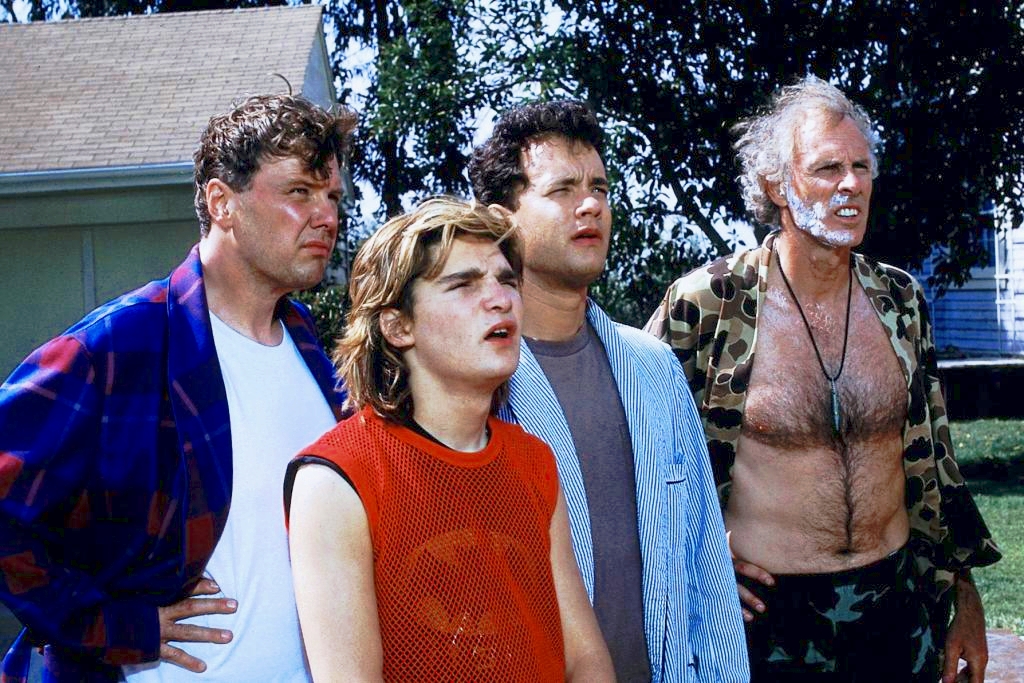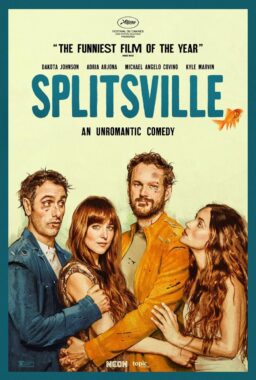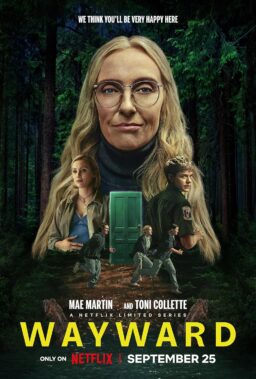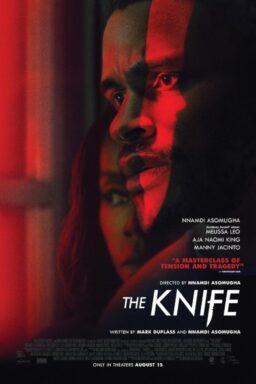Sometimes I miss channel surfing. It’s an act of digging amidst a more passive activity—just hanging around, being lazy. That’s how many discovered Joe Dante’s 1989 horror satire “The ‘Burbs”—on a random channel on many a weekend afternoon, which befits its tone: hanging around, being lazy. Even the title setting boasts laxness, fit for couch potatoes whose gaze wanders between shows. It became a classic for those who remember being suspicious of their odd neighbors, only really knowing them by peeking through their windows.
“The ‘Burbs” takes the trope of the spooky house down the block and turns it into a swipe at how peaceful living is a crock. Courtesy of Shout Select, which has remastered other rerun treasures, a Blu-ray with a new 2K transfer arrives this week. It’s a classic wind-down, not just for its audience, but for horror, the deceptive “Morning in America” Reagan-era, director Dante, and its star Tom Hanks, whose casual robe and vacation clogs could also be seen as an outfit for a mental patient.

Though not as iconic as “Gremlins” or “The Howling,” this send-up of the bone-white suburban America prevalent in Dante’s work finds him distancing from the Spielbergian influence that made him bankable. Produced during the 1988 writers’ strike, it’s a rest stop in between practical effects extravaganzas “Innerspace” and “Gremlins 2: The New Batch.” “The ‘Burbs” finds a primary special effect in its ensemble, including Hanks, Carrie Fisher, Bruce Dern, Rick Ducommun, and Corey Feldman. Many dialogue scenes were improvised, particularly those between on-screen beaus Hanks and Fisher, and the actors are given a chance to stretch some physical comedy muscles. The joy of the film is watching the promise of peace in these charming houses completely blow up in our faces. It’s Dante’s answer to “Blue Velvet.” You know, for kids.
Ray Peterson (Hanks) enters a waking nightmare by looking curiously upon his neighbor’s house. Just like most of the other Mayfield houses, it’s a large white house, but this one is neglected—caked with dirt, surrounded by dead grass, plus a peculiar tendency to blow gusts of leaves at whoever steps upon their grounds. Scored by a gothic organ—one of the many great touches in Jerry Goldsmith’s score—this situation seems like something we have seen many times before. But the next day, it’s as though it never happened. A breezy, light chorus of strings ushers in the morning paper boy, a symbol of squeaky cleanliness that nevertheless brings about the earliest instances of ire amongst the citizens. Ray throws his coffee at him, the toupeed Walter (Gale Gordon of Lucille Ball fame) shakily grumbles at him and promptly ignores Ray’s salutation. Off goes Queenie, the Bichon Frise that would best be known for American nightmare “The Silence of the Lambs,” onto Mark Rumsfield’s lawn for a morning poo, much to the violent chagrin of Rumsfield (Bruce Dern). Always clad in fatigues or camo underwear, Rumsfield is a symbol of the militarized patriotism, the fear of “the Other,” that birthed suburbs, and doofy, wife-fearing Art (Ray Ducommun) who is introduced by wearing branches as camouflage, pointing a rifle at backyard birds, is the after-effect of such militarization. It’s treated as normal behavior. Mayfield Place doesn’t have to devolve into insanity by the end of the movie; it’s already reached it.
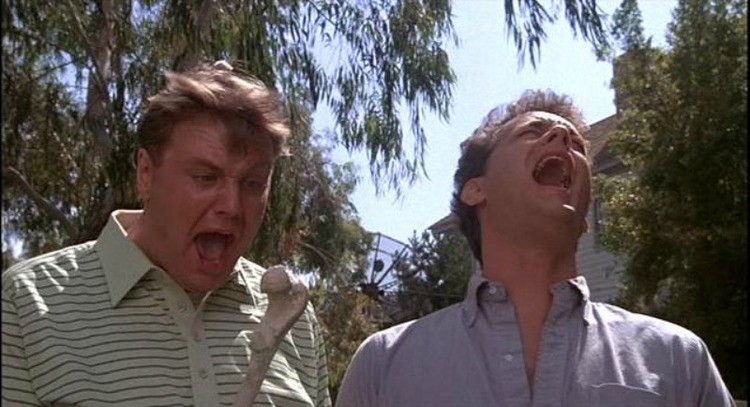
But one piece is crucial, and that’s the meatball next door himself, Ricky Butler (Corey Feldman). A skate rat slacker with seemingly no parental guidance and no real beef with anyone on the block, Ricky’s the chill audience surrogate, gleefully accepting and encouraging the goings-on. For “The ‘Burbs”’ legion of fans, he matches their enthusiasm by gushing “God, I love this street.” He accepts the realness of it all, even bringing his friends over for a front row seat to the insanity. The adults hang out with Ricky because he’s still old enough to foster similar suspicions about perceived crazies like Skip, a soda jerk who allegedly kept his family in their basement. In the case of their mysterious neighbors, the Klopeks (a family whose names nobody can be bothered to pronounce properly), history may be repeating. There’s no proof of this, even though an event as strange as flickering basement lights, implosions, and smashing large bags into garbage cans fuel their theories.
All this, of course, worries the neighborhood wives and mothers—Carol Peterson (Carrie Fisher) and Bonnie Rumsfield (Wendy Schaal), initially the more rational members of the crew. Particularly Carol, who only mildly tolerates Ray’s decision to loaf around at home on his vacation. She wants the nuclear family image—a husband with a kid and a dog, going away to the cabin for relaxation. Ray, although milder Art or Rumsfield, represents the arrested development that comes with being a grown-up in the ‘burbs. In one classic scene late in the movie, after Hanks endures a ghastly nightmare that leaves mouthing along with the Mister Rogers’ Neighborhood theme in a state of shock, Carol adopts the protective mother role and keeps her husband in. With an aw-phooey kick of the pavement from Art’s checkered slip-ons, Art and Rumsfield sulk away after pleading for him to come out.
Hanks was not quite yet America’s Dad, but “The ‘Burbs” shows him developing that role. It was a reluctant choice—he didn’t feel comfortable with the idea of having a kid in the movie, which explains the underdevelopment of his son. Filmed immediately after wrapping “Big,” the role of Ray seems like a more abstract version of a little kid in a man’s body. In both films, Hanks finds ways to balance the thoughtful, gentle side and the loud yelling he does terrifically. It’s a role tailored to such skills—he’s soft and laid-back, but when he explodes, he does so in a way that is funny, but you know he means it. And it shows the depth and complexity he’ll later find in more dramatic roles.

The key to the film’s success is its ability to build from a simmer to combustion—in both Hanks’ performance, and especially in one key scene: meeting the Klopeks at their house. According to Olsen, this was the most difficult scene to shoot in the movie. How do you get the suspicious parties together without having a huge confrontation? Having long suspected the Klopeks of ghoulish play, they finally work up the nerve to cross the street and say hello. Dern nearly walks away with the whole scene with a mix of quiet physical comedy (peeling wall paper, rearranging a painting) and line delivery (“good solid walls, good solid floors!”), but it’s the movie boiled to its essence—moments of chill punctuated by brief, energetic bursts: The slow, excruciating chew of Hanks on a sardine, encouraged by Fisher’s hilarious nod, bookended by the demonic gravel of Brother Theodore (an eccentric who’d gained notoriety by appearing on late night talk shows), plus the amiable eccentricity of pathologist Werner Klopek (Henry Gibson). At this point, the cinematic angles get lower, enhancing the horror.
For a seemingly slight, small film, there’s no end of goods to dig up from “The ‘Burbs.” One in particular is the score. When discussing great scores, comedies are seldom mentioned, but Goldsmith’s work on “The ‘Burbs” is a banger. Fluctuating between the intense and easygoing, with the addition of Ennio Morricone’s spaghetti western sounds—plus cues from Goldsmith’s own score for “Patton”—it’s a sonic reflection of a population influenced by watching far too many movies on lazy Saturdays in the suburbs.
“The ‘Burbs” was not a critical success. (Our fearless leader Roger, in his review, may as well have been Rumsfield making heads or tails out of that pathology painting.) But the film’s influence can still be felt in films as recent as Jordan Peele’s Oscar-winning, suburban screed “Get Out.” The characters—even the brief, brilliant appearances by bickering garbagemen Dick Miller and Robert Picardo—are so beloved, they could’ve inspired their own spinoffs.
The Shout Selects disc features the commentary track from the UK Arrow release with screenwriter Dana Olsen, plus a massively entertaining documentary with Dante, Feldman, and various cast and crew. Bits of information make reading the film richer, such as learning that the film initially began as a television pilot called “Bay Window,” a wink to Hitchcock that fits with the voyeurism theme. With actual fake news inspiring more suspicion and crackpot theories, “The ‘Burbs” has lost none of its freshness. Nearly 30 years later, we’re still looking out our windows, wondering what our neighbors are up to.
To order your copy of “The ‘Burbs” from Shout Select, click here.
